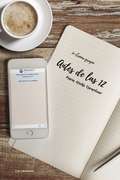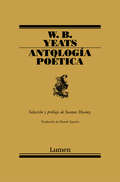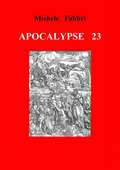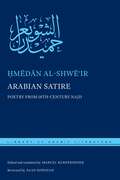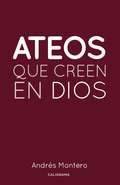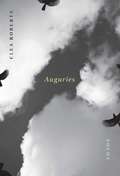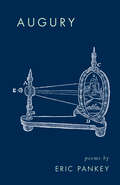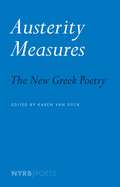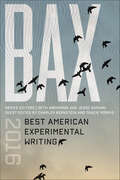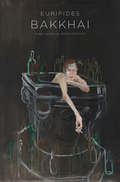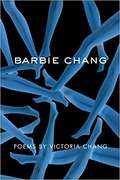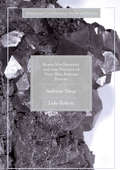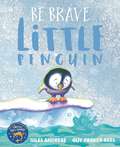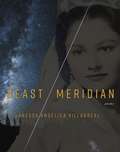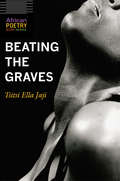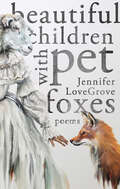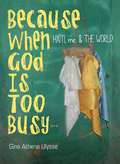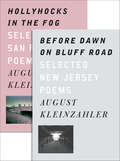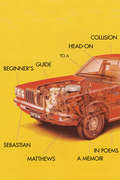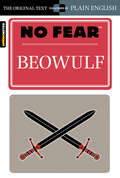- Table View
- List View
Antes de las 12
by María Stockli EsparducerTrocitos de alma que encontré abandonados en un grupo de Whatsapp. <P><P>Antes de las 12 es una recopilación de poemas en forma de mensajes, de palabras escritas en folios que se van consumiendo y de trocitos de alma que encontré abandonados en un grupo de Whatsapp.
Antología poética
by William Butler YeatsW.B. Yeats es, junto a Ezra Pound y T.S. Eliot, el gran renovador de la poesía europea del siglo XX. W.B. Yeats es, junto a Ezra Pound y T.S. Eliot, el gran renovador de la poesía europea del siglo XX. Nacido en Irlanda, su obra está transida de la mitología céltica, los ritmos del modernismo sajón y la fiebre de sus pasiones ocultistas y esotéricas. Lumen presenta aquí una rigurosa antología de toda su obra, seleccionada y prologada por el también irlandés y Premio Nobel de Literatura Seamus Heaney. La traducción corre a cargo de poeta Daniel Aguirre, quien ha llevado a cabo una impecable versión rimada, sin duda una de las aportaciones más brillantes que se han hecho a la traducción de poesía en nuestro país.
Apocalypse 23
by Michele FabbriUne compilation de poésie obscure et inquiétante: qui habet aurem audiat...
Arabian Satire: Poetry from 18th-Century Najd (Library of Arabic Literature #49)
by Ḥmēdān al-ShwēʿirThis lively volume collects poems by Hmedan al-Shwe'ir, who lived in Najd in the Arabian Peninsula shortly before the hegemony of the Wahhabi movement in the early eighteenth century.A master of satire known for his ribald humor, self-deprecation, and invective verse (hija'), Hmedan was acerbic in his criticisms of society and its morals, voiced in in a poetic idiom that is widely referred to as “Nabati,” here a mix of Najdi vernacular and archaic vocabulary and images dating back to the origins of Arabic poetry. In Arabian Satire, Hmedan is mostly concerned with worldly matters, and addresses these in different guises: as the patriarch at the helm of the family boat and its unruly crew; as a picaresque anti-hero who revels in taking potshots at the established order, its hypocrisy, and its moral failings; as a peasant who labors over his palm trees, often to no avail and with no guarantee of success; and as a poet recording in verse how he thinks things ought to be.The poems in Arabian Satire reveal a plucky, headstrong, yet intensely socially committed figure—representative of the traditional Najdi ethos—who infuses his verse with proverbs, maxims, and words of wisdom expressed plainly and conversationally. Hmedan is accordingly quoted by historians of the Gulf region and in anthologies of popular sayings. This is the first full translation of this remarkable poet. A bilingual Arabic-English edition.
Ateos que creen en Dios
by Andrés MonteroTodas las madres ateas son creyentes en Dios. Cualquiera que ame tiene fe. Ateos que Creen en Dios es una abstracción expresionista del concepto de Dios en forma de metáfora poética. <P><P>Ese concepto, la idea de Dios y principalmente de su naturaleza, representan el mayor reto intelectual y sentimental de la historia del ser humano.No hay nada comparable a la idea de Dios en cuanto a exigencia de esfuerzo mental, de capacidad de entendimiento y de imaginación. <P>Todos quienes profesan fe, con independencia del culto religioso al que se adscriban, buscan el discernimiento de Dios. En ese esfuerzo, la poesía se revela como vehículo estético y semántico para acercarnos a la comprensión de Dios. <P>Los poemas de esta obra formulan que el amor y la fe son equivalentes, mientras que ateísmo y confesión religiosa representan dos modos antagónicos de intelectualizar sentimentalmente a Dios.
Auguries
by Clea RobertsWhether speaking of erotic love, domestic life, spiritual wilderness, or family entanglements, the poems of Auguries, the much-anticipated second collection from Yukon poet Clea Roberts, are saturated with their northern landscape. Roberts is well versed in the distances and dynamics between tedium and ecstasy, light and dark, isolation and solitude, freeze and thaw, flow and stillness. Her poems are spare and clean, each like a single larch in an immense white plain; their exactness startling and arresting. As the Gerald Lampert Award jury citation for her celebrated first book noted, “Her images . . . are not only crisp and precise, but manage to speak about the physical conditions of this place and its emotional landscape in one and the same lyrical breath . . .” Written during a period in which Roberts both became a parent and lost a parent, the poems in Auguries lend themselves to prayer, surrender, celebration, reconciliation, meditation, and auspice. Tell me how to breathe between the painful and the beautiful, my lips, my eyelids slow with cold. (from “Cold Snap”) “Clea Roberts writes poems of clear, quiet beauty. They contain the silence of perception: alive to the world with open eye and open heart.” — Anne Michaels
Augury: Poems
by Eric PankeyFrom award-winning poet and author of Crow-Work, a collection exploring the presence of the divine in the seemingly ordinary. The ancient Romans practiced augury, reading omens in bird&’s flight patterns. In the poems of Augury, revelation is found in nature&’s smallest details: a lizard&’s quick movements, a tree scarred by lighting, the white curve of a snail&’s shell. Here the sensory world and the imagined one collide in unexpected and wonderful ways, as Pankey scrutinizes the physical for meaning, and that meaning for truth. With uncommon grace, each of Pankey&’s precise lyrics advances our shared ontological questions and expresses our deepest contradictions. In a world of mystery, should we focus on finding meaning or creating it? How can the known—and the unknown— be captured in language?Augury is a masterful and magical collection from a poet of stirring intelligence, &“a book of stones unstitched from the wolf&’s belly.&”Praise for Augury &“A darkly luminous book by a poet at the height of his considerable poetic power.&” —Kathy Fagan, author of Moving & St. Rage &“This is a book I will keep close at hand, alongside the best work of Montale, Dickinson, Celan, and Stevens. This is a book one will turn to again and again.&” —Rebecca Dunham, author of Cold Pastoral &“Each ethereal image he weaves into his work is delicately curated, whittled down through his attention to sound. . . . Pankey&’s poems destabilize as they straddle time and place, and he looks askance at the narrow way in which language is often viewed.&” —Publishers Weekly
Austerity Measures: The New Greek Poetry
by Karen Van DyckA remarkable collection of poetic voices from contemporary Greece, Austerity Measures is a one-of-a-kind window into the creative energy that has arisen from the country's decade of crisis and a glimpse into what it is like to be Greek today.The 2008 debt crisis shook Greece to the core and went on to shake the world. More recently, Greece has become one of the main channels into Europe for refugees from poverty and war. Greece stands at the center of today’s most intractable conflicts, and this situation has led to a truly extraordinary efflorescence of innovative and powerfully moving Greek poetry. Karen Van Dyck’s wide-ranging bilingual anthology—which covers the whole contemporary Greek poetry scene, from literary poets to poets of the spoken word to poets online, and more—offers an unequaled sampling of some of the richest and most exciting poetry of our time.
BAX 2016: Best American Experimental Writing (Best American Experimental Writing)
by Seth Abramson and Jesse DamianiBAX 2016: Best American Experimental Writing is the third volume of this annual literary anthology compiling the best experimental writing in poetry, fiction, and creative nonfiction. This year's volume, guest-edited by Charles Bernstein and Tracie Morris, features seventy-five works by some of the most exciting American poets and writers today, including established authors—like Sina Queyras, Tan Lin, Christian Bök, Myung Mi Kim, Juliana Spahr, Samuel R. Delany, and even Barack Obama—as well as emerging voices. Intended to provoke lively conversation and debate, Best American Experimental Writing is an ideal literary anthology for contemporary classroom settings.
Bakkhai
by Anne Carson EuripidesA stunning, new translation by the poet and classicist Anne Carson, first performed in 2015 at the Almeida Theatre in London Anne Carson writes, “Euripides was a playwright of the fifth century BC who reinvented Greek tragedy, setting it on a path that leads straight to reality TV. His plays broke all the rules, upended convention and outraged conservative critics. The Bakkhai is his most subversive play, telling the story of a man who cannot admit he would rather live in the skin of a woman, and a god who seems to combine all sexualities into a single ruinous demand for adoration. Dionysos is the god of intoxication. Once you fall under his influence, there is no telling where you will end up.”
Barbie Chang
by Victoria Chang"With astringent understatement and wry economy, with nuance and intelligence and an enviable command of syntax and poetic line, Victoria Chang dissects the venerable practices of cultural piety and self-regard. She is a master of the thumbnail narrative. She can wield a dark eroticism. She is determined to tackle subject matter that is not readily subdued to the proportions of lyric. Her talent is conspicuous."―Linda Gregerson "Chang's voice is equal parts searing, vulnerable, and terrified."―American Poets Barbie Chang, Victoria Chang explores racial prejudice, sexual privilege, and the disillusionment of love through a reimagining of Barbie―perfect in the cultural imagination yet repeatedly falling short as she pursues the American dream. This energetic string of linked poems is full of wordplay, humor, and biting social commentary involving the quote-unquote speaker, Barbie Chang, a disillusioned Asian-American suburbanite. By turns woeful and passionate, playful and incisive, these poems reveal a voice insisting that "even silence is not silent." From "Barbie Chang Lives": Barbie Chang lives on Facebook has a house on Facebook street so she can erase herself Facebook is a country with no trees it allows her to believe people love her don't want to cover her Barbie Chang . . . Victoria Chang is the author of three previous poetry books. In 2013, she won the PEN Center USA Literary Award and a California Book Award. Chang teaches poetry at Chapman University and lives in Southern California.
Barry MacSweeney and the Politics of Post-War British Poetry: Seditious Things (Modern and Contemporary Poetry and Poetics)
by Luke RobertsThis book examines the literary impact of famed British poet, Barry MacSweeney, who worked at the forefront of poetic discovery in post-war Britain. Agitated equally by politics and the possibilities of artistic experimentation, Barry MacSweeney was ridiculed in the press, his literary reputation only recovering towards the end of his life which was cut short by alcoholism. With close readings of MacSweeney alongside his contemporaries, precursors, and influences, including J. H. Prynne, Shelley, Jack Spicer, and Sylvia Plath, Luke Roberts offers a fresh introduction to the field of modern poetry. Richly detailed with archival and bibliographic research, this book recovers the social and political context of MacSweeney's exciting, challenging, and controversial impact on modern and contemporary poetry.
Be Brave Little Penguin
by Giles AndreaeA feel-good rhyming story with a positive message about confidence and self-esteem, from the creators of international bestseller, Giraffes Can't Dance.Little Penguin Pip-Pip would love to join in with all his friends swimming in the sea, but there's just one problem . . . he's scared of water. Can Pip-Pip overcome his fears and finally take the plunge? This irresistible story shows that sometimes all it takes is a little bit of encouragement - and a whole lot of heart - to finally make that leap!This touching tale will soon become a new family favourite.Praise for Giraffes Can't Dance:'All toddlers should grow up reading this or hearing their parents read it aloud to them' - Daily Telegraph'A rhyming story with superb illustrations' - Independent'This delightful picture book is written in lively rhyming text with vivacious illustrations' - Junior
Beast Meridian
by Vanessa VillarrealBEAST MERIDIAN narrates the first- generation Mexican American girl, tracking the experiences of cultural displacement, the inheritance of generational trauma, sexist and racist violence, sexual assault, economic struggle, and institutional racism and sexism that disproportionately punishes brown girls in crisis. <p><p> Narrated by a speaker in mourning marked as an at- risk juvenile, psychologically troubled, an offender, expelled and sent to alternative school for adolescents with behavioral issues, and eventually, a psychiatric hospital, it survives the school to prison pipeline, the immigrant working class condition, grueling low- pay service jobs, conservative classism against Latinxs in Texas, queerness, assimilation, and life wrapped up in frivolous citations, fines, and penalties. The traumatic catalyst for the long line of trouble begins with the death of a beloved young grandmother from preventable cervical cancer—another violence of systemic racism and sexism that prevents regular reproductive and sexual health care to poor immigrant communities—and the subsequent deaths of other immigrant family members who are mourned in the dissociative states amidst the depressive trauma that opens the book. <p> The dissociative states that mark the middle—a surreal kind of shadowland where the narrator encounters her animal self and ancestors imagined as animals faces brutal surreal challenges on the way back to life beyond trauma—is a kind of mictlan, reimagined as a state of constant mourning that challenges American notions of "healing" from trauma, and rather acknowledges sadness, mourning, and memory as a necessary state of constant awareness to forge a "way back" toward a broader healing of earth, time, body, history.
Beating the Graves (African Poetry Book)
by Tsitsi Ella JajiThe poems in Tsitsi Ella Jaji’s Beating the Graves meditate on the meaning of living in diaspora, an experience increasingly common among contemporary Zimbabweans. Vivid evocations of the landscape of Zimbabwe filter critiques of contemporary political conditions and ecological challenges, veiled in the multiple meanings of poetic metaphor. Many poems explore the genre of praise poetry, which in Shona culture is a form of social currency for greeting elders and peers with a recitation of the characteristics of one’s clan. Others reflect on how diasporic life shapes family relations. The praise songs in this volume pay particular homage to the powerful women and gender-queer ancestors of the poet’s lineage and thought. Honoring influences ranging from Caribbean literature to classical music and engaging metaphors from rural Zimbabwe to the post-steel economy of Youngstown, Ohio, Jaji articulates her own ars poetica. These words revel in the utter ordinariness of living globally, of writing in the presence of all the languages of the world, at home everywhere, and never at rest.
Beautiful Children with Pet Foxes
by Jennifer LoveGroveBeautiful Children with Pet Foxes, the new collection of poetry from Giller Prize–longlisted writer Jennifer LoveGrove, attempts to make sense of a difficult and unsettling world, where one need not look much further than their own communities to witness acts of trauma and absurdity.Here, we're haunted by the ghosts of alienation, trauma, delusion, and fear that the past decade has instilled in us, and bear witness to moments of extreme crisis—in emotional breakdowns, the failures of the mental health system, the lack of support for the most vulnerable members of society, and the impact of psychosis not only on the ill but on those orbiting them.With inventive and startling imagery and logic, we're led on an odyssey through the terrain of startling dreamscapes, where a whole host of personas, both tame and wild—from humans, to foxes, moose, deer and crows, slugs, fish, beetles, mosquitos, earthworms, and more—give voice to the things we can't express in our daily lives.
Because When God Is Too Busy: Haiti, me & THE WORLD (Wesleyan Poetry Series)
by Gina Athena UlysseGina Athena Ulysse's Because When God Is Too Busy: Haïti, me & THE WORLD is a lyrically vivid meditative journey that is unapologetic in its determination to name, embrace and reclaim a revolutionary Blackness that has been historically stigmatized and denied. Crafting experiments with "ethnographic collectibles" of word, performative sounds, and imagery to blur genres and the lines between the geopolitical and the personal, this collection is a testament to postcolonial inheritances. Ulysse's work remixes samples from a range of references as it beckons readers to bear witness to a coming of age as she shifts between time and place and plays with languages to stretch the margins of aesthetics in the academic. These poems, performance texts, and photographs gather fractured memories—longings laced with Vodou chants confronting a past that looms too largely in the present. Because When God Is Too Busy searches for humility while honoring sacred and ancestral imperatives to recognize and salute power beyond Western attachments to reason.
Before Dawn on Bluff Road/Hollyhocks in the Fog: Selected New Jersey Poems/Selected San Francisco Poems
by August KleinzahlerA collection of August Kleinzahler’s best poems, divided—like his life—between New Jersey and San FranciscoWhen August Kleinzahler won the 2004 Griffin Poetry Prize for his collection The Strange Hours Travelers Keep, the judges’ citation referred to his work as “ferociously on the move, between locations, between forms, between registers.” They might also have added “between New Jersey and San Francisco,” the places Kleinzahler has spent his life traveling between, both on the road and on the page. This collection assembles the best of his New Jersey and San Francisco poems for the first time, organized according to place, with each city receiving its own title and cover. Providing readers with a gorgeous guide to Kleinzahler’s interior geography, Before Dawn on Bluff Road (New Jersey) and Hollyhocks in the Fog (San Francisco) function as both word-maps and word-anatomies of one of our greatest poet’s lifelong passions and preoccupations.
Beginner's Guide to a Head-On Collision: A Memoir in Poems
by Sebastian MatthewsThe award-winning author of In My Father&’s Footsteps combines prose and poetry in a poignant memoir that captures the aftershocks of a tragic car accident. &“Beginner&’s Guide to a Head-on Collision offers the deeply moving poetic memoir of Sebastian Matthews&’s life in the years after the car accident that devastated him and his wife and son. The poems, which often read like electric improvised prayer-songs, intimately evoke the terrors and wonders of catastrophic physical injury and of &‘life re-booted.&’ They are disturbing, eerie poems that embody the paradoxes of being The Dead Man at the crossing. They are amazingly honest in their hopeful, mystical sense of fate. In this unforgettable book, the reader is present at the scene of the accident where the hovering spirit that has departed the body addresses the living person re-entering his brokenness and answering for his transcendent awareness.&” —Kevin McIlvoy, author of Hyssop &“These poems detail both physical and spiritual misery, and though suffering can turn us into many things, Matthews—our banged-up storyteller, singer, docent—strives to deliver himself back to a body of affection, intimacy, and kindness. Beginner&’s Guide to a Head-on Collision is a remarkable record of that difficult journey.&” —Patrick Rosal, author of Brooklyn Antediluvian &“By reading Beginner&’s Guide to a Head-on Collision we learn how to go in and out of the body as necessary and, in order to take in the possibility of a larger life, how to wrest from breakage release from our thin views of who we are.&” —Vievee Francis, author of Forest Primeval
Beowulf (No Fear #3)
by SparkNotesRead great works of literature with NO FEAR—and actually understand what they mean!No Fear Literature puts the world&’s finest books at your fingertips! With the complete original text on the left-hand page, and an easy-to-follow translation on the right to guide you, you can fully grasp the meaning and brilliance of each classic. Although Beowulf is a masterpiece of early English literature, written approximately between 975 and 1025, the unfamiliar dialect makes this epic poem difficult to understand. Thanks to this translation, placed right near the original text, readers can now appreciate the battle of good and evil that unfolds between the wise and heroic Beowulf and his enemies—the monstrous Grendel and a fire-breathing dragon. Each No Fear guide contains: The complete original textA line-by-line translation that puts the text into everyday languageA complete list of characters with descriptionsPlenty of helpful commentary

